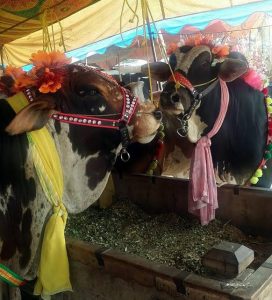Peshawar: In the wake of incidence of Congo virus infection surfacing in parts of the country ahead of Eid-ul-Azha – the Muslim feast of sacrifice – authorities in Khyber Pakhtunkhwa have initiated a preventive campaign to protect public from the deadly virus.
The campaign comes after the scare last year when on the occasion of Eid-ul-Azha, 13 out of the 43 suspected cases of Crimean-Congo hemorrhagic fever (CCHF) at the Hayatabad Medical Complex (HMC) in Peshawar died due to the infection.
Together with reports from elsewhere in the country that indicated vulnerability of the public to the virus, the authorities have moved to inform people about the risk at a time when people handle sacrificial cattle and are exposed to bite from the tick that carries the CCHF vector.
“We feel that a massive information campaign is needed to educate people about the Congo virus that is transferred through tick bites from animals to people and from animals to animals through infected blood and body secretions,” said Dr. Syed Masoom Shah, District Director of KP’s Livestock and Dairy Development Department.
Shah said that people working in the veterinary sector, owners and traders of cattle as well as men working in slaughterhouses had been asked not to touch the tick with bare hand and not to remove ticks from animals with hands.
“People handling cattle should ensure removal of ticks with gloves,” Shah told News Lens Pakistan. “Children should not be allowed to go to cattle markets. People visiting cattle markets to buy sacrificial animals should wear clothes of light colour so that ticks crawling on them could be spotted easily.”
He said there were no symptoms of Congo virus infection in case of animals but the moment it is transferred to human beings, they get very sick. Symptoms, said Dr. Shah, included high fever, dizziness, itching eyes, headaches, joint and muscle aches, red blotches on the body and bleeding from the nose.”

Data shared by the Livestock Department shows that a total of 130 check posts have been established throughout the province where 529 workers are busy spraying the sacrificial animals with pesticides as they enter the province from other cities.
The Department has also set up seven camps at Kaka Mandai, Naguman, Larama, Palosai, two on Ring Road and one at the veterinary hospital in Peshawar to check animals for the ticks.
Spokesperson for Hayatabad Medical Complex, Tauheed Bibi, said that out of 43 patients suspected of Congo virus infection reported at the facility in 2015, 29 were Afghans. 14 out of the 43 were tested positive for the virus, of which only one person survived. HMC is the only hospital in the city where a where a Congo isolation unit has been established.
Bibi said this year, six suspected cases of CCHF had been reported at HMC. Of these, she said, three had tested positive for Congo virus. Two of them had died of infection.
“The number of patients suspected of Congo virus increase ahead of Eid-ul-Azha due to free movement of sacrificial animals within and between cities and commuters and cattle traders frequently come in contacts with them,” said Bibi.
Javed Khan, a cattle trader in Peshawar’s Kaka Mandi who brings sacrificial animals from Punjab to Khyber Pakhtunkhwa, said he brought nearly 100 animals to Peshawar on a daily basis, two weeks ahead of Eid-ul-Azha.
He said he wasn’t aware of the Congo virus but had heard about cases of infection on media and become cautious. He said many buyers touched the cattle to check if they were healthy for sacrifice and did not care about getting infected with the virus.
“The preventive campaign is all the more necessary because of the public’s attitudes and ignorance of the disease,” said Khan. He said very few cattle traders use preventive measures like wearing gloves before touching animals and need to be sensitized about the disease.
The World Health Organization (WHO) fact sheet on Congo virus says the CCHF cases have a fatality rate of up to 40 per cent. It says the hosts of the CCHF virus include a wide range of wild and domestic animals such as cattle, sheep and goats.
Many birds are resistant to infection, but ostriches are susceptible and may show a high prevalence of infection in endemic areas, where they have been in contact with human cases, said the fact sheet.
It is difficult to control or prevents CCHF for multiple reasons, according to WHO: “The tick-animal-tick cycle usually goes unnoticed and the infection in domestic animals is usually not apparent.”
Secondly, the tick vectors are numerous and widespread, so tick control with acaricides (chemicals intended to kill ticks) is only a realistic option for well-managed livestock production facilities.
However, preventive measures can be taken against the disease by wearing protective gloves, light colour clothes for easy detection of ticks, use of repellent on skin, and avoiding areas where ticks are abundant, says the WHO fact sheet.
Doctors in HMC are concerned about Congo patients coming from Afghanistan. He suggested there should be a health team deployed on border to check Afghan patients for Congo virus to help them reach HMC in isolation. He said there was no proper treatment for CCHF but supportive care to help patients recover from the disease. He said the chances of a patient recovering increase if the infection is reported at an early stage.



